How You Can Create a Highly Effective Campaign Website for Under $200
Yes, you need a political campaign website. It doesn’t matter how small your campaign is. It’s very affordable and you don’t need much in the way of technical skills these days. You just need to know which tools to use and learn how to use them. In this article, we’ll walk you through the entire process, step by step.
We’re going to show you one way you can build out your campaign website. Like most things in technology, there are many, many ways to solve a problem. Our solution is based on a framework called WordPress and it’s based on decades of experience and hundreds of website development projects for small businesses, non-profits, and political campaigns. The “recipe” we’re going to give you is a balance between simplicity and functionality.
How much does it cost?
The methodology we’re going to show you in this article will cost you as little as $48 for a year of hosting and as much as $264 if you opt for all of the bells and whistles.
- Domain registration – $12/year (even less with coupons or sales pricing)
- Website hosting – $3 – $12 per month
- Website technology – WordPress is free
- Additional services – Donation, email, and analytics services range from free to $9 per month
Do I need to be a computer genius?
No! You need some computer skills and a time investment but it’s worth the effort. We’ll provide you with most of what you need to get your campaign website up and running.
We’ve put together a massive, 92-page ebook that covers all of these aspects and more. This blog post covers some of the material included in the Website chapter of the Political Campaign Digital Infrastructure ebook:
- Website
- Accepting Donations
- Social Media
- Contact Database
- Communication and Collaboration
- Analytics
This is a long post, so here’s a list of the campaign website topics we’ll cover:
- Register your domain
- Select a web hosting company
- Install WordPress
- Select a theme and install your plugins
- Create campaign website pages
- Set up web analytics
- Integrate with email and payment services
But first, let me answer a question you may be asking…
Why Your Campaign Needs a Website
So, why exactly do you need a website? Here are some of the top reasons.
Owning vs. Renting: Sometimes renting can be a smarter decision than buying, but not in this case. Putting all of your eggs in one basket can be very risky. If you’re relying on either Facebook or a free hosting solution (like WordPress.com or Weebly), you’re facing some serious risks.
- They can lock you out. There is no guarantee of service with these free accounts. All of their terms of service state that they can shut down on a moment’s notice. And most of them stipulate that they don’t have to give you your content back.
- They can evict you. Your account can be removed at any time, for any reason, and usually without recourse. There are countless stories of Facebook, Twitter and blog accounts that get shut off and even deleted. Sometimes these are accidental, other times they are due to alleged violations of terms of service, but every so often there is no explanation.
- They can use your stuff. On most of these networks, their terms of service state that while you maintain ownership of your content, you also grant them a universal right to reuse your content for their own purposes.
- They can relocate you. If a service gets acquired, its domain name might change, which means that your URL would change. The most valuable online currency is inbound links. If your domain changes, those links get broken and you have no power to repair them.
- They own your improvements. Search engine rankings are always maintained at the domain level. If your personal website is “jondipietro.wordpress.com,” then all the search engine “juice” allocates to “wordpress.com.” You can’t really earn any ranking for yourself.
Search Engine Optimization (SEO): If voters are interested in learning about you, one of the first things they’ll probably do is type your name into a search engine. What will they find? If you don’t have a website, it’s going to be very, very difficult to show up in those search engine results.

Features: There are certain features you want on your website that may be either difficult or impossible to do without one. Some of these include accepting online donations, making it easy for people to find your policy positions, and monitoring traffic. If you have your own website, you can do all of these and more.
Growth: Maybe this year you’re running for school board, but who knows what the future holds? Maybe a run for mayor or even governor is in the cards. Having your own website means that it will be able to grow with you and meet the needs of new campaigns.
Analytics: Management expert Peter Drucker is often quoted as saying that “you can’t manage what you can’t measure.” Part of managing your political campaign is understanding the all-important digital component. Without sufficient analytics, you’re flying blind in that regard.
One way to think about your online presence is to think in terms of outposts and a home base. Marketing expert and social media pioneer Chris Brogan had this explanation in a blog post:
If you think of your main website as your home base (be that a blog or a shopping site or a corporate site) and if you think of all the social networks as outposts, then you’re halfway to understanding one of the best ways to market online, in my not-‐so-‐humble estimation. The trick is this: knowing when to engage on the outpost and knowing when to drive people back to the home base.
Common Objections
Even if you buy into the reasons why a website is so important, many of you will have some common objections.
It’s too expensive. This one is just flat-out not true. Using the tools and providers we’ll show you in this guide, you can have a professional, highly functional website for as little as $5 per month.
I’m not technical. This objection is completely understandable. We’re not here to tell you it’s dead-simple to build a website. However, it IS something anyone can do if they invest the time. We’ll walk you through the process and point out free resources where you can get the information you need (our Basic Training customers have access to an entire technical video library). And we’ll also show you some resources that can help you take care of the more “techy” parts for very short money.
Sounds like overkill. We disagree. It’s easy enough and inexpensive enough these days that there really is no excuse for not having this valuable asset for your campaign.
Now that we’ve (hopefully) convinced you to move forward, here are the steps you’ll need to follow.
Step 1: Register Your Domain
 The first thing you will need to do is register a domain name (if you don’t already own one). We recommend that you choose a domain name that isn’t specific to either the year office for which you’re running. Otherwise, you’ll be investing time and money into a single-use website. That’s terribly wasteful. You may think that you’ll never run for office again, but you never know what the future will hold.
The first thing you will need to do is register a domain name (if you don’t already own one). We recommend that you choose a domain name that isn’t specific to either the year office for which you’re running. Otherwise, you’ll be investing time and money into a single-use website. That’s terribly wasteful. You may think that you’ll never run for office again, but you never know what the future will hold.
If you’re not sure how to register a domain, we’ll show you how shortly. But before you go ahead and decide on a domain name, you should probably do a wider search to see what’s available on the various social networks as well. It can be really challenging sometimes to find domains and social media handles that aren’t already used.
Keep in mind that there are several social media channels that restrict your username to 15 characters. You want to be as consistent as possible among all of these channels. The ideal situation would be to have the same domain name and social media username everywhere. But that’s not always possible.
Thankfully, there are some services out there that can help perform some of the legwork for you. Both namecheck.com and KnowEm allow you to type in a name and they will instantly search registered domain names and social media users to tell you what’s available and what isn’t.
These tools will check domains and social media channels and tell you if they’re available. Here’s an example of one such search:
In order to register a domain name, you’ll need to use a domain registrar. There are literally thousands of Internet domain registrars, but here is a short list of the most popular:
- GoDaddy (www.godaddy.com)
- Namecheap (www.namecheap.com)
- com (www.register.com)
The costs are fairly comparable but we think GoDaddy’s good customer support and affordability make it one of the best choices right now.
Step 2: Select a Website Hosting Company
After securing a domain, next you’ll need to find a place to host your website. Before deciding on a web host, it’s best to select the software you’ll be using to build your website and then select a host that specializes in supporting that platform. At Candidate Boot Camp, we strongly recommend WordPress to build your website, but there are lots of other viable options.
About Those Campaign Website Builders
There are several hosting providers that offer their own “website builders” and there are even some free versions available. They’re very tempting, especially for people who are intimidated by technology. However, there are some significant downsides to these solutions.
- They’re Messy. What I mean by this is that the code they generate is extremely complicated. The result is that search engines have a harder time processing them and your search results suffer. It also frequently means that they are slower because it takes more work for browsers to process them.
- They’re Limited. Your website builder may be able to create a nice homepage and some issue pages, but how easy is it to build a compliant donations page? Can it integrate with an email program? Can you connect all three of those together? As you expand your website during the course of your campaign, it’s likely that there are features you’ll want that the builder doesn’t support.
- They’re Obvious. It’s usually pretty clear when your website uses one of these website builders. Sometimes, they actually say it at the bottom of the pages. The templates they offer make your website look like most others and, frankly, they frequently don’t look all that great. This can affect your credibility as a candidate.
Campaign Website Hosting Recommendations
Here is a (very) short list of some of the top WordPress hosts:
- HostGator (recommended)
- BlueHost
- GoDaddy
- WordPress.com
If you’re running a relatively small, local campaign then your web hosting needs will be modest. You won’t need a whole lot of storage or generate a whole lot of traffic. You’ll want a host that provides decent features but more importantly provides solid, timely support. All of the hosts above are affordable and provide support that ranges from acceptable to decent. Because they’re relatively low-cost, none of them provides fantastic support. Those hosting options will cost you considerably more.
PRO TIP: For those who aren’t comfortable with technology, we recommend using the same company to host both your domain and your website. This removes an additional layer of configuration that you won’t have to worry about.
Configure DNS
This is one spot that can be a little confusing. If you are using the same company to host your domain name and your website, you can skip this step!
Otherwise, you will need to tell your domain host where you’re hosting your website. You accomplish this by configuring your DNS (Domain Name System) settings. Your website host will tell you the IP address of your website and you’ll need to enter that number into your DNS records.
If you have trouble with this, the easiest thing to do is contact your domain host’s technical support and they can walk you through it.
Step 3: Install WordPress
Why WordPress?
Before we explain why we recommend WordPress, we should probably explain what it is. It’s a web Content Management System (CMS), which is sort of like an “instant website; just add water.” A CMS is a platform that stores all of the content in a database rather than in files that need to be coded, then uploaded to the website.
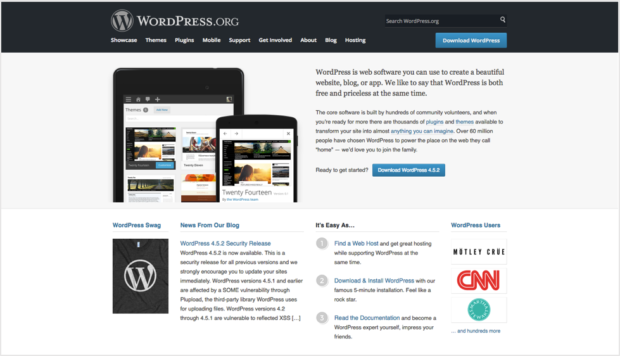
This provides a number of advantages:
- CMS websites use “skins” or “themes” to control the look and feel. This means they can be changed and updated very easily without modifying the individual pages.
- The content is modified using easy-to-use interfaces instead of having to modify HTML code. If you can use Microsoft Word, you can manage a CMS website.
- There is no software required in order to make changes to a CMS website. You just log in with the proper credentials, and the CMS has all the tools required to update it.
- CMS websites are extensible. “Extensible” means that you can install plugins and modules that are like mini-programs that add features and functionality to your website. Some are free, and others are premium.

Editing a web page in WordPress is as easy as using a word processor. Once you’re logged in, you can edit pages, insert pictures and videos, and make any other necessary changes using the built-in editor.
Step 4: Select a Theme and Install Your Plugins
In this section, we’ll walk you through the process of setting up your website and provide some advice on which pages you need and how to meet the basic technical needs for your campaign.
WordPress is a blogging platform that has matured over the years into a full-blown CMS. It has an enormous library of free themes and plugins and a huge marketplace for premium extensions as well. WordPress is very easy to use and contains lots of important search engine optimization features right “out of the box.” For these reasons and more, Candidate Boot Camp highly recommends using it to build your website.
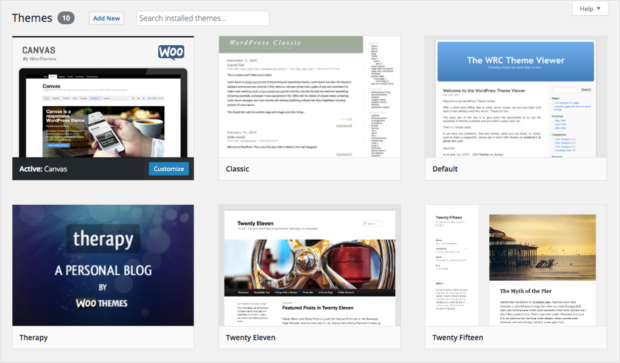
There are thousands of free and low-cost “themes” available for WordPress. With a single mouse-click, you can update the entire look and feel of your website: It defines the fonts, the colors, the layout, the menu appearance, etc.
Where to Find WordPress Themes
The easiest (and cheapest) place to find themes for your campaign website is the WordPress repository. You can search and install them right from the dashboard under Appearance – Themes. There are thousands of free WordPress themes you can choose from.
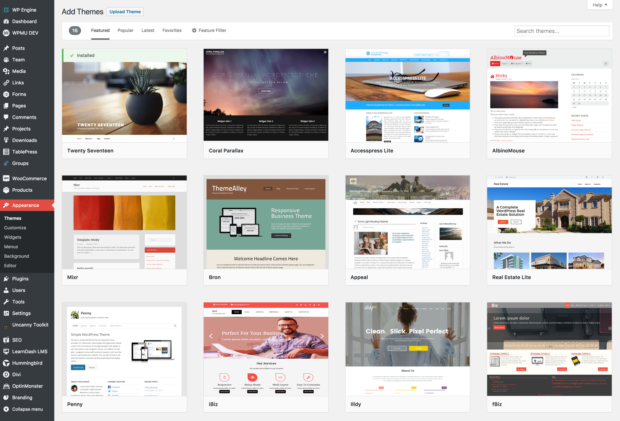
Having said that, using free themes does have its drawbacks. In many cases, you get what you pay for. These themes are not always updated regularly, which can sometimes create security risks. They also don’t have as many options as premium themes. Some websites that offer very functional and cost-effective themes include Elegant Themes and ThemeForest.
Recommended Plugins
If you’re not using WordPress, then this section won’t apply to you. Plugins are extensions you can install on your WordPress site to provide new features and functionality. For example, there are plugins that help with search engine optimization, install tracking codes (for analytics), and much more.
Here’s a list of a few plugins we think are really helpful.
iThemes Security
I’m guessing you’re not a website security expert. Despite the fact that I’ve been developing websites for nearly 20 years, neither am I! This free plugin is easy to install and configure and it will go a long way toward locking down your WordPress environment to prevent it from being hacked.
SumoMe
This free plugin will allow you to easily incorporate those social media buttons on your website that allow people to easily share your pages to Facebook, Twitter, LinkedIn, etc. It has some other very powerful features, like the ability to create popup windows to ask for donations or email subscriptions. I know you probably hate them as a user but, trust me, they work!
If you upgrade to the professional version ($20/month), it unlocks even more powerful features. But the free version should be good enough for most smaller campaigns.
Yoast SEO
When you install this plugin, a new area appears in the edit screen when you’re creating or updating a page. It allows you to enter a “focus keyword” and then proceeds to point out things you can do on the page to improve its SEO. For example, if you’re working on the “About Me” page you would probably want to put the office you’re running for in the focus keyword. You probably don’t need to optimize for your name because it’s probably going to be quite obvious to Google already. On an issue page, you’d use the issue as the focus keyword (e.g. “school district budget”).
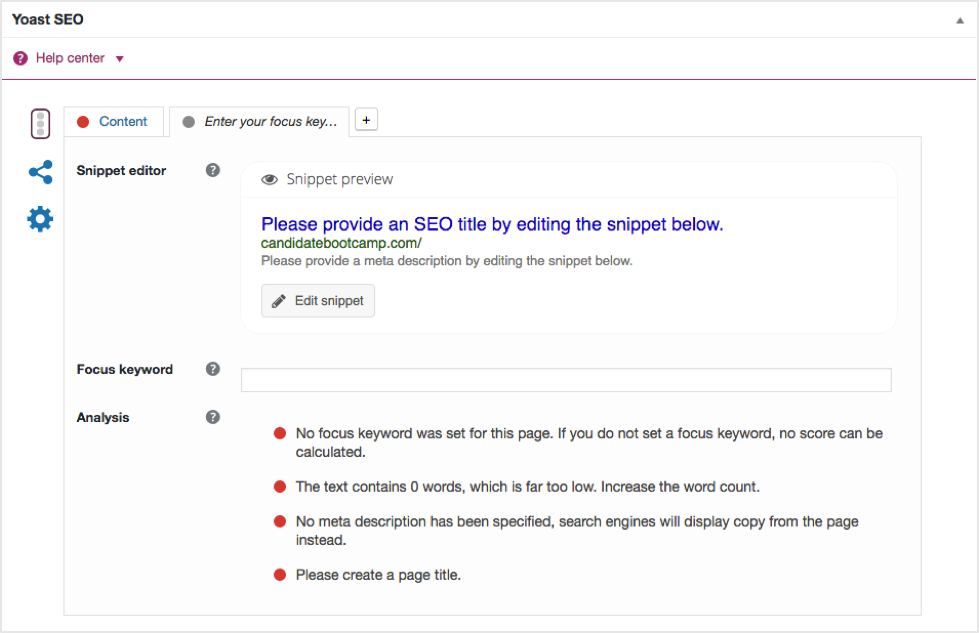
Step 5: Create campaign website pages
Before you start creating pages, you’ll want to map out your content plan. There are a few key pages every candidate will need. You don’t have to follow our menu structure verbatim, but try to cover all of these bases:
- Homepage
Your homepage should have your picture on it, your main message, and no more than two or three calls to action (e.g. donate, volunteer, subscribe, register for an event, etc.) - About
Tell voters why you’re running, why you’re qualified, and what you’ll accomplish. People are investing in outcomes, not you. Like any other product or service, they want to know how you’re going to make their lives better. - Issues
Our Issue Profile Worksheet walks you through the process of analyzing the top-three issues your campaign should focus on. Once you’ve completed that process, your website should have a single page with your main issues and/or individual pages dedicated to each issue. - Donate
Fundraising is the hardest and most important aspect of your campaign. It is critical that your website makes it as easy as possible for people to donate to your campaign. - Volunteer
Similarly, if someone is willing to donate their time, you need to make it easy for them to get in touch with you. Your volunteer page could be as simple as a signup form or could include specific roles that need filling. If you have a contact form, some of the options you’ll want to provide include requests for lawn signs, offers to make calls, knock on doors, write letters to the editor, host a house party, or poll-stand on election day. - Contact
You need to also have a generic Contact Us page, with your mailing address, phone number, physical address (if applicable), email address, and a contact form. - Blog (News and Events)
If you’re using WordPress, this is quite easy to do. In fact, it’s built in. You can use the blog to easily craft position statements, share news about media coverage, and announce upcoming events.
Obviously, building a website can be as simple or as complex as you want to make it. We’re assuming that most of this audience wants and/or needs to keep it simple. For that reason, we’re just going to cover a few tips to cover some of the basics.
For those who want to really dive in, or already have a web presence, we’ve included a comprehensive Digital Marketing Evaluation guide as an appendix to this ebook. You can walk through a detailed process that will give you a very good picture of the overall health of your website (and social media) effectiveness.
Search Engine Optimization
We could write an entire ebook on the subject of search engine optimization (SEO), which means making sure that search engines like Google will find you. However, here are a few high-level tips that will help prevent some of the more egregious mistakes:
- Pay attention to your page titles. Make sure they are meaningful. For example, your homepage title should be “John Doe, Candidate for Anytown School Board” and not simply, “Home.”
- Mention your state or town/city frequently on the website. This will help the search engines to be certain about your locality.
- Utilize the blogging feature on your website to create as much content as possible. Search engines like sites with lots of pages that are dynamic. If your site has three pages and never changes, that’s not very interesting.
- Get as many backlinks as possible. This means asking other websites to create links to yours. This may include your local political party, like-minded bloggers, media websites, and supporters of your campaign. These links are one of the most important factors search engines consider when ranking different websites: The more links there are on the web that point to your website, the higher you’ll rank.
Text and Images
People hate long pages with lots of text and no pictures. Break up your web pages with some images and try to keep your copy as concise as possible. Use short words in short sentences in short paragraphs with lots of white space. You’re aiming for about a sixth-grade reading level, not because your voters are stupid, but because the easier it is to read your stuff, the more people will read. Complex writing fatigues your brain more quickly so make it easy on your readers!
The Flesch-Kincaid Grade Level test rates text on a U.S. school grade level. For example, a score of 8.0 means that an eighth grader can understand the document. There are online tools that will measure this for you (including one of our recommended plugins below).

Mobile
You can expect around half of all of your website traffic to come from mobile devices, and even more if you use social media extensively. Your website must be mobile-friendly! If you’re using WordPress, be sure to select a theme that is mobile-responsive, which means that it automatically adjusts (or “responds”) itself based on smaller screen sizes. This way, your text is more readable and your navigation menus are more usable.
Note: If you’re taking our Basic Training Course, you have access to an entire WordPress video tutorial library that covers everything you need to know to build and maintain your website.
Step 6: Set up web analytics
You can’t manage what you don’t measure. That’s a common saying in the business world. You may think you have bigger fish to fry than to worry about analyzing your web traffic, but it can come in pretty handy if you’re advertising. It will allow you to measure how much traffic you’re getting from email vs. Facebook vs. Google vs. newspaper articles, etc. It will also tell you which pages people are visiting on your website. This will give you a feel for which issues resonate most with voters (assuming you have a separate page for each).
We recommend installing both the Google Analytics and Facebook tracking codes on your website. Both are free and each one gives you different insights into your web traffic.
Google Analytics
To get set up with Google Analytics,
- If you don’t already have an email address connected with a Google account, you’ll have to create one.
- Go to Google.com/Analytics and sign into Google Analytics
- Click on the Sign up button and fill out the account information
- Copy the tracking code and install it on your WordPress website. Most themes have a place in the configuration dashboard for you to install the tracking code. If yours doesn’t, then you can install the Tracking Code Manager plugin and it will allow you to install the necessary code.

Once your tracking code is installed and collecting data, you’ll be able to see how many visitors you’ve had to your website and lots more. The following is a screen shot of the default Overview report. It shows the number of visits (sessions), visitors (users), pages viewed (pageviews), etc.

Another useful report is to find out where your website traffic is coming from. You can find this under the Acquisition tab on the left. This will show you how much of your traffic came from social media, paid search, organic search engines, email campaigns, etc.

Another handy feature is monitoring which pages on your website are getting the most traffic. You can see this information under Behavior.
Step 7: Integrate with email and payment services
Now that your website and its baseline pages are done, you may want to integrate it with some third party services to kick things up a notch. Some of these are paid services while others have free versions.
As we discussed in our Technology Stack, our prioritized recommendations are:
- Donations
- Contact Database (email)
- Analytics
- Social Media
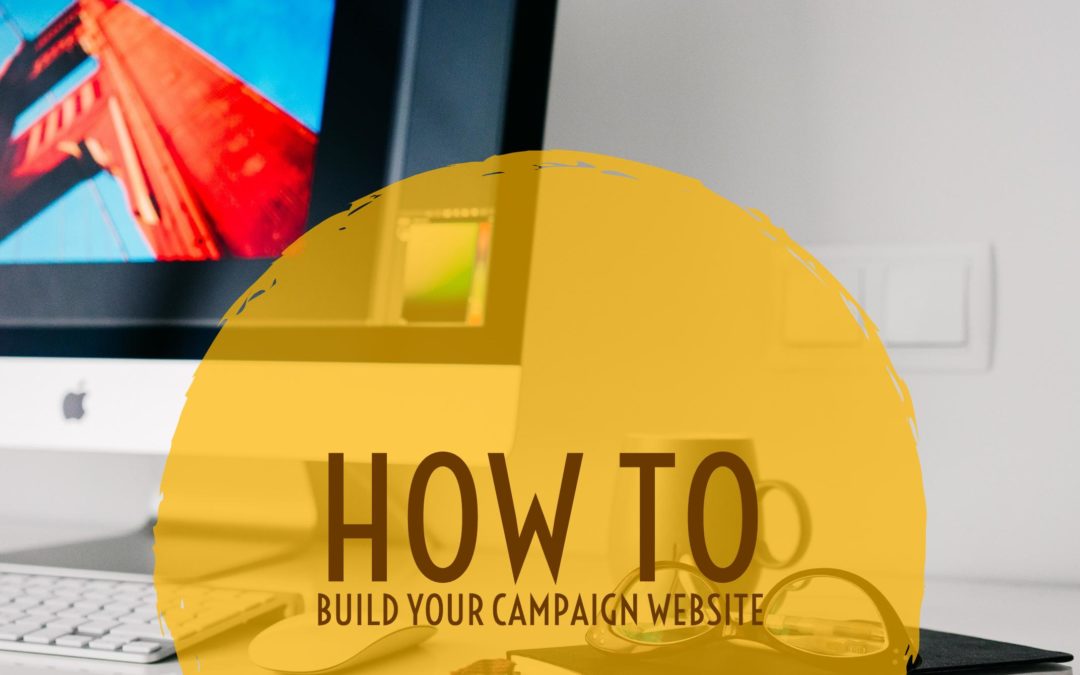



I’m looking to create a political cause/issue website that will have the following features:
A blog, newsletter, fund raising ability, petition signing, video/photos, social media connections, and a on line store. I intend on making this a super pac through the Federal Government. Is this possible? Can I create this without technical support?
Hi Marc,
It’s possible but will require a lot of research and work on your part. You could start by reading our Political Campaign Digital Infrastructure ebook (https://candidatebootcamp.com/product/political-campaign-digital-infrastructure/). This is geared toward candidates but all of the information contained in it would be relevant to your project. It would at least get you started.
Good luck!
Best domain: .com or .net or .org??????
Hi Ellen,
From a search engine (e.g. Google) perspective, they are equivalent so there’s no particular advantage of one over the other. However, many people will instinctively type “.com” after a domain name and so there is a slight possibility of brand confusion. Personally, my preference is in the order you listed – .com, .net, then .org.
But you also need to take the competition into account. For example, if the domain you want already has a .com registered and there’s no live website then there is less risk that people will accidentally end up in the wrong place. However, if there is already a well-established website at that domain, it has the potential to cause more confusion.
Hope that helps!
Would you recommend starting to build a campaign website before I officially announce? That way I have a website I can go live with right after announcing, or should I just wait until I announce?
Yes! You only get one chance to announce and if you plan properly, it will be one of the highest visibility days of your campaign. It’s ideal if you can have a website ready to go with the ability to collect donations, especially if you’ve planned out your announcement day strategy.
I am finishing up a textbook on political campaigning for the first time office seeker. At 83, with 65 + years in the political arena, as a worker not an office holder, I am versed in the paper era, but not the digital age. How can I learn more of your program and incorporate it into my book? And how can I refer potential candidates to you, since I am not an expert by far.
Hi Peter, That’s great! We have lots of resources for you to consider…
Here are some ebooks we offer:
And we also offer a full training course on Social Media for Political Campaigns.
I just sent a comment and I am not sure it went out. Did you receive it or not?
Hi Peter – Your first comment was flagged for moderation for some reason. I’ve approved and responded.